Various use cases are assumed for RIC (RAN Intelligent Controller), which is a RAN operation automation function that uses AI/ML. This blog post describes the RIC Use Cases. RIC is optimization function and operation automation for 5G NR and 4G LTE radio network (RAN: Radio Access Network).
In addition, I will also explain the relationship between the operation of the existing RAN and the SON (Self-Organized Network), which is legacy automation function, and the RIC.
What is RIC where AI/ML is used?
RAN is a radio access network such as 5G, 4G and 3G. RAN controls the wireless connection with terminals (such as smartphones). RIC (RAN Intelligent Controller) optimizes limited RAN radio resources and automates RAN operations.
Wireless mobile networks such as 5G, 4G, and 3G use very limited wireless bandwidth and limited computing resources to carry out massive wireless RAN communications. RIC uses AI/ML-based software to efficiently utilize limited wireless bandwidth and computer processing resources.
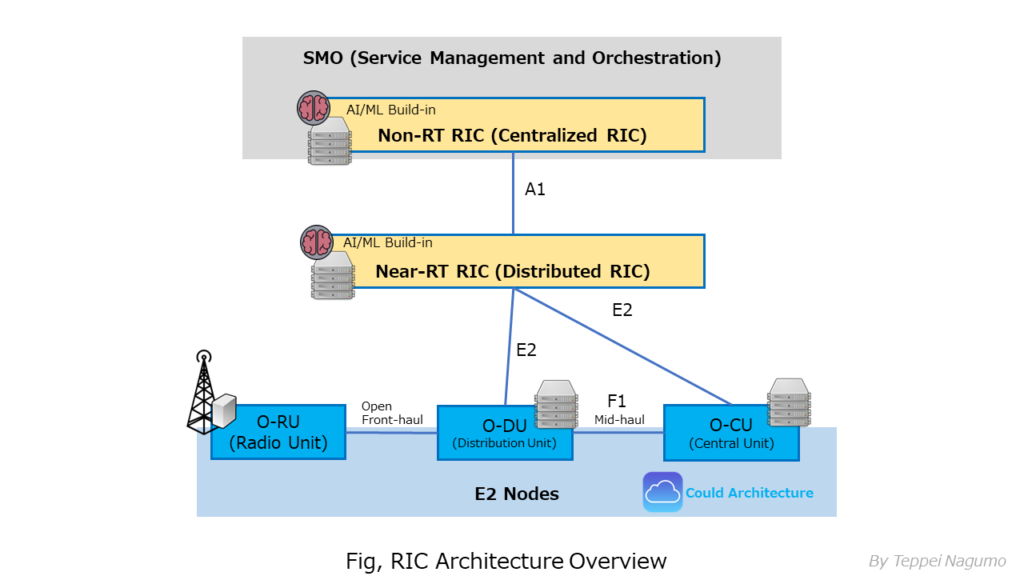
The concept of RIC is based on software open interface system. For more detailed RIC concept and architecture, please refer to the following blog post.
3 type of RIC functions
The functions of RIC can be roughly classified into the following three types (see the figure below). RIC is defined by standardization organizations (O-RAN alliance, Telecom Infra Project, ONF, etc.) as a software function aimed at automating RAN operations and optimizing networks. In addition, RIC assumes the use of AI/ML (artificial intelligence and machine learning).
Actual RIC functions include various different kinds of functions related to automation of RAN operations and RAN optimization. The relationship between the existing legacy SON and RIC, and the relationship between the existing legacy RAN (TRAN: Traditional RAN) and RIC are shown in the figure below.
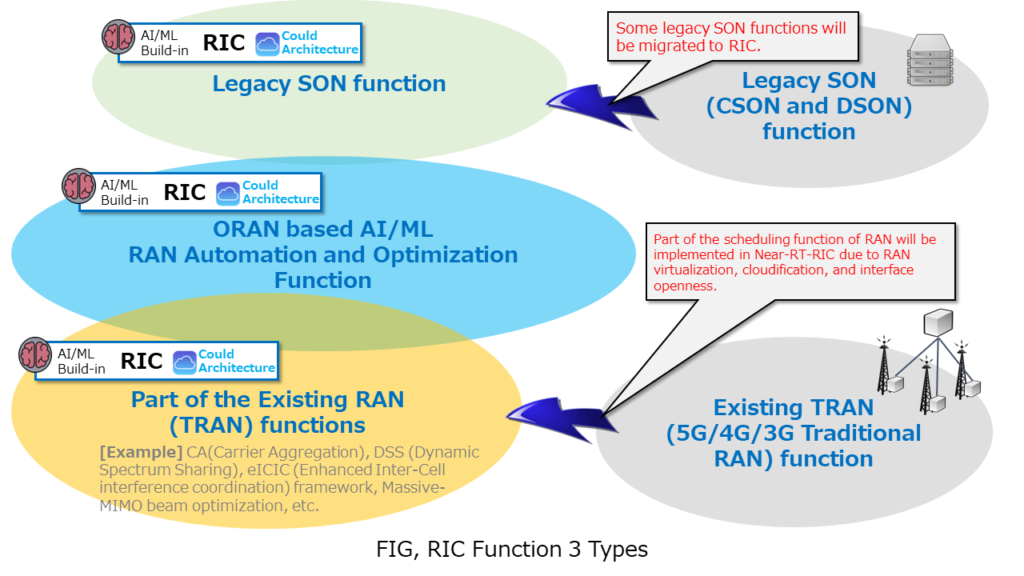
ORAN based AI/ML RAN Automation and Optimization
This RIC function type is automation and optimization functions for AI/ML-based RAN operations. The open of RAN specifications promoted by the ORAN alliance and the automation function by RIC that assumes software functions are classified into this function type.
Non-RT-RIC (None Real-Time RIC) is defined as part of SMO (Service Management and Orchestrator). Also, Near-RT-RIC (Near Real-Time RIC) is defined as a RIC that operates near the RAN baseband unit. Non-RT-RIC and Near-RT-RIC work together.
Legacy SON (CSON and DSON) function in RIC
Existing SON functions that are implemented and operated as RICs are included in this function category.
Most mobile telecom operators operate existing networks. Traditional 4G/3G network operation and optimization functions are already operational as SON. SON is divided into CSON (Centralized SON) and DSON (Distributed SON). SON includes many software systems independently developed, maintained and operated by operators.
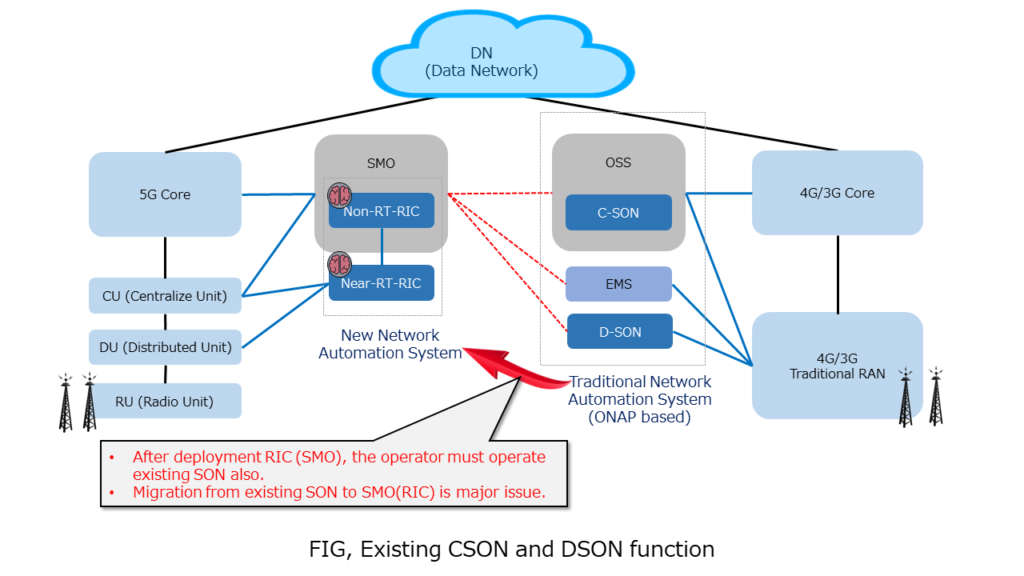
- [Glossary]
- SMO: Service Management and Orchestration
- Non-RT-RIC: None Real-time RAN Intelligent Controller
- Near-RT-RIC: Near Real-time RAN Intelligent Controller
- SON: Self-Organized Network
- CSON: Centralized self-Organized network
- DSON: Distributed self-Organoid network
- EMS: Element Management System
- TRAN: Traditional Radio Access Network (Used for VRAN)
Simultaneous operation of 4G/3G existing RAN (TRAN) SON functions independently developed by operators and new AI/ML-based RIC (SMO) functions is expected to be a common problem for most operators. It is also expected that the migration of functions from SON functions to RIC functions will be a common problem for most operators.
Part of the existing RAN (TRAN) function implemented in RIC
Cases where some of the functions of RAN (TRAN: Traditional RAN) are implemented as RIC functions are classified into this function type. In particular, cases where some of the RAN traffic scheduling functions are implemented as Near-RT-RIC functions fall into this function type.
It is expected that some of the BaseBand (BB) processing functions that were processed in the BaseBand Unit (BBU) of 5G/4G RAN in the Traditional-RAN (TRAN) will be implemented as Near-RT-RIC functions. The purpose is to achieve more efficient baseband processing and traffic scheduling processing using AI/ML. In addition, this trend is also the flow of OPEN technical specifications for RAN, led by the ORAN Alliance.
- [Existing RAN functions implemented in RIC]
- DSS (Dynamic Spectrum Sharing): Technology that uses the same radio frequency band for 5G NR and 4G LTE
- ICIC (Inter-Cell interference coordination) and eICIC (Enhanced Inter-Cell interference coordination) framework: Technology that reduces radio interference and improves communication speed for terminals using the motivations of macro base stations and small base stations.
- CA (Carrier Aggregation): Technology for bundling and simultaneously using multiple different radio frequency bands to increase communication speed
- Massive-MIMO beam optimization: Technology that has the effect of reducing beam-forming and Massive-MIMO multi-antenna processing for terminals, reducing radio interference, and lowering transmission power.
8 RIC Use Case Category classification
RIC functions include various RAN operation automation and optimization functions. This blog post classifies RIC functions into the following 8 categories in terms of use cases. The table below classifies RIC use cases by category.
RIC is a new AI/ML-based operational automation and optimization capability for RAN. In addition, RIC replaces SON, which is the automation function of Traditional-RAN (TRAN). Furthermore, Near-RT-RIC implements some of the RAN functions, which part of the scheduling function for protocol processing that handle RAN traffic.
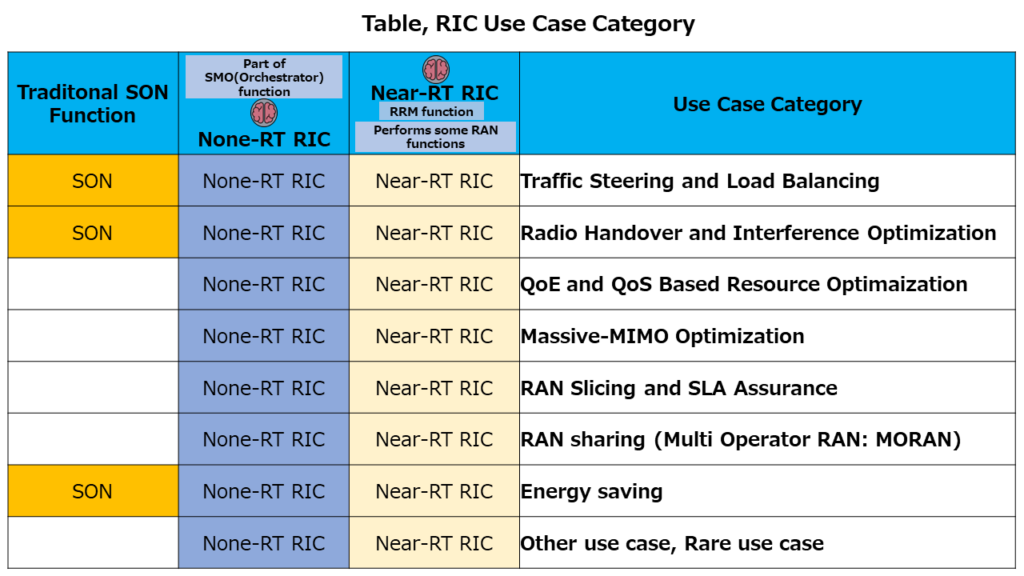
- [Glossary]
- QoS: Quality of Service
- QoE: Quality of Experience
- Massive-MIMO: Massive Multi Input Multi Output
- SAL: Service Level Agreement
RAN Traffic Steering and Load Balancing
Distributes or balances the load of processing of RAN traffice. Distributes or balances the RAN load according to the network conditions and the performance of terminals (subscribers connected to RAN, such as smartphones).
The processing load is distributed between devices that perform RAN baseband processing, and the processing load is distributed between processors. A function that allows RIC to proactively optimize network conditions and terminal performance using AI/ML.
This function assumes load distribution or balancing for baseband processing units, processing chip units that perform baseband processing, and wireless cell units.
- [Example of specific functinos]
- Intelligent Radio Call Coverage and Capacity Optimization
- Accurate Real-time UE Location Data Tracing
- Predictive Load Balancing (Cell, RU Level)
- User Level Predictive Load Balancing
- Mobility Load Balancing (Inter-Frequency and Inter-RAT Mobility Load Balancing)
Radio Handover and Interference Optimization
Features in this Use Case category are concerned with interference control of RAN wireless connections. This feature requires controlling wireless connectivity in several different base stations (baseband processors) simultaneously. Therefore, processing is performed to link different base stations (baseband processors).
By reducing the interference of wireless connections, the limited wireless resources can be used efficiently during terminal communication. By reducing radio interference, it increases the number of users (capacity) that can be accommodated per cell of the RAN and improves the radio connectivity of users. This improves the quality of RAN communication (QoS: Quality of Service).
- [Example of specific functions]
- Inter-Frequency Handover Optimization
- Inter-RAT (5G NR – 4G LTE, 4G LTE – 3G) Handover Optimization
- V2X (Vehicle-to-anything) Handover Optimization (UE-to-UE Slide Link Handover Optimization)
- Interference Mitigation: Uplink Channel Estimation
- Interference Mitigation: ICIC and eICIC Framework
- Intelligent Secondary Cell Selection for CA (Carrier Aggregation)
QoS and QoE Based Resource Optimization
Through QoS analysis and prediction, the radio resource consumption of RAN radio connections and the processing resource consumption of RAN equipment are efficiently consumed. By streamlining the consumption of wireless resources, the quality of RAN connectivity is improved. And then, RAN quality of service (QoS) is improved, resulting in improved user experience (QoE).
The source data for QoS is multiple different data such as RAN User Traffic Data, QoS measurements (KPI/KQI values based on RAN Network counters), and Network Measurement Report messages sent from terminals to the network. This user case category function comprehensively analyzes those data using AI/ML. Based on QoS analysis results, it decides how to allocate RAN processing resources (radio resources and computational resources) to appropriate subscribers.
- [Example of specific functions]
- QoS Based Radio Resource Optimization
- Network KPI Anomalies Detection
- Network Fault Prediction and Optimization
- VoLTE and VoNR Service Quality Optimization
- Real-Time Video Traffic Optimization (Include UAV: Unmanned Aerial Vehicle)
- Subscriber QoS Optimization
- [Glossary]
- VoLTE: Voce Over LTE
- VoNR: Voce Over New Radio
- UAV: Unmanned Aerial Vehicle
- KPI: (Network) Key Performance Indicator
- KQI: (Network) Key Quality Indicator
Massive-MIMO Optimization
Massive-MIMO is a spatial multiplexing technique for radio wave propagation. Massive-MIMO improves wireless communication speed and communication quality. Massive-MIMO is a multi-antenna technology that uses multiple antennas.
Massive-MIMO processing is optimized for the purpose of improving QoS and QoE of radio communication in RAN. By optimizing Massive-MIMO processing, the efficiency of the radio frequency used (Spectral Efficiently) and the power saving of wireless communication (Energy Efficiency) are achieved.
In Traditional-RAN (TRAN), Massive-MIMO antenna processing is performed by protocol processing of Layer-1 (physical layer) of RAN. When RIC is introduced, Near-RT-RIC will handle Massive-MIMO optimization.
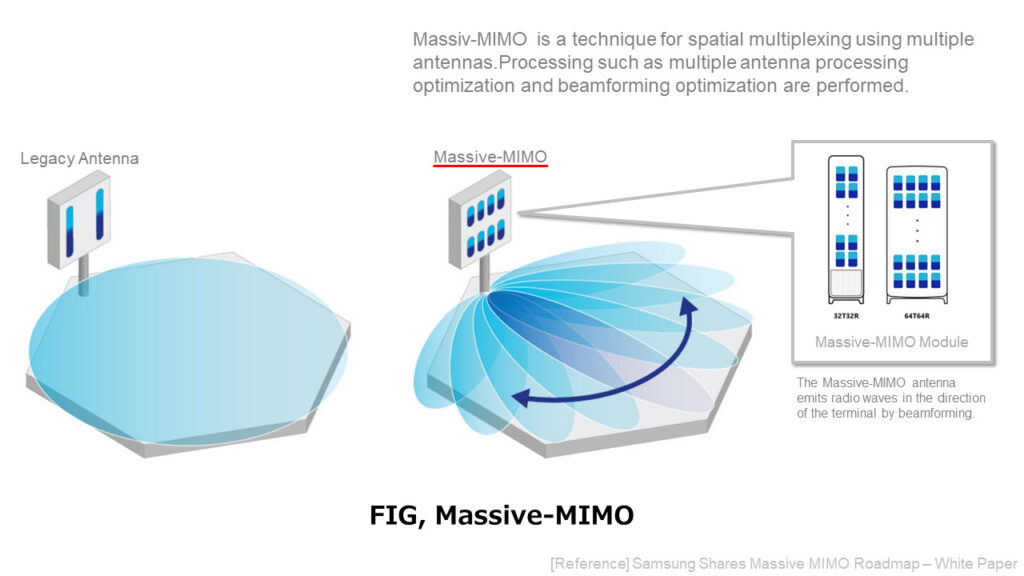
The above diagram is taken from Samsung’s white paper.
[Samsung White Paper, Massive-MIMO, PDF file , Samsung site]
RAN Network Slicing and SLA Assurance
After the commercialization of 5G SA, network slicing technology is a commercialized technology. The RAN domain function of network slicing is called RAN slicing. RIC controls the communication quality and bandwidth of RAN slices according to the SLA (Service Level Agreement) for each RAN slice.
In RAN, available processing resources (computing resources and radio resources) change depending on the state of communication. RIC dynamically controls SLA for each RAN slice while understanding RAN processing resources.
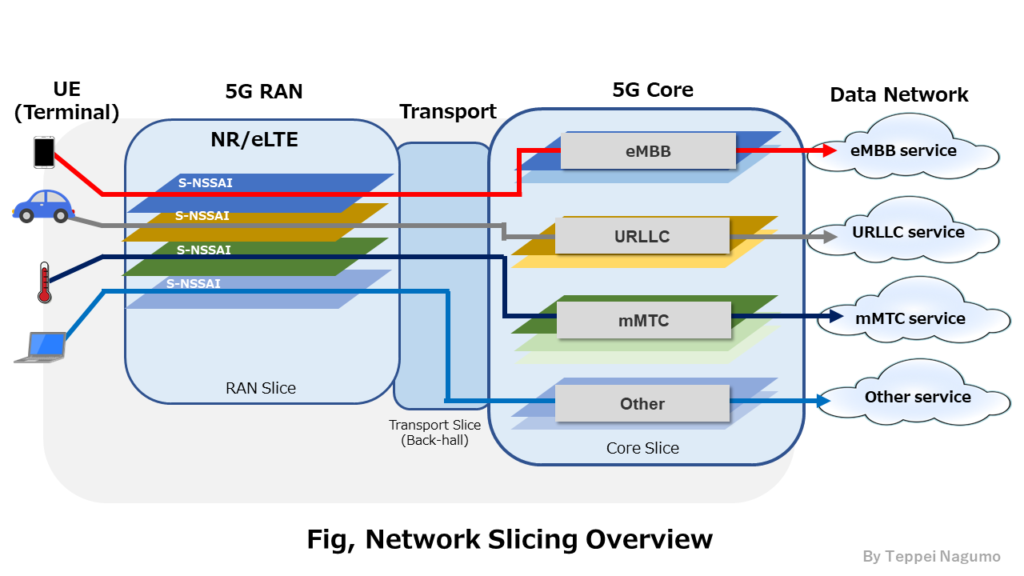
For more information about network slicing, please refer to the following blog post.
RAN Sharing (MORAN: Multi Operator RAN)
RAN infrastructure sharing is where multiple operators share the resources (computing and radio resources) of a single RAN. This technology is used in sparsely populated areas and areas where it is extremely difficult to install base stations.
RAN infrastructure sharing requires RAN virtualization (VRAN). By virtualizing RAN, one RAN device (or one DRAN site) is shared by multiple operators. RIC makes RAN computing and radio resources (spectrum) available to multiple operators.
RAN infrastructure sharing is also known as site sharing. It is also called MORAN (Multiple Operator Radio Access Network). The figure below is taken from publicly available information.
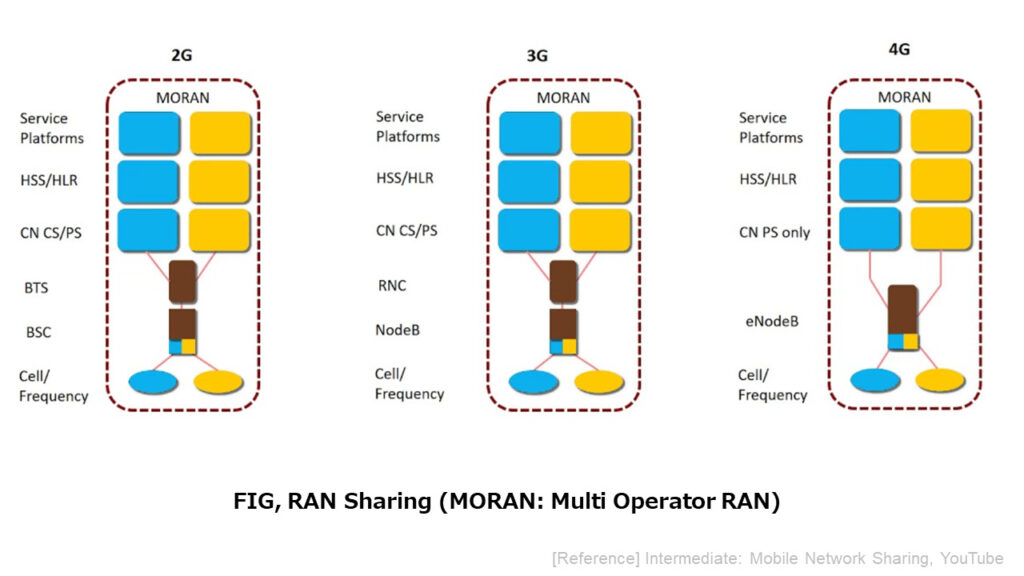
RAN Energy Saving

RIC reduces RAN power consumption. RIC saves power at the hardware device level and reduces wireless transmission power.
RAN power saving with Non-RT-RIC optimizes RAN power consumption from the perspective of overall RAN management. Near-RT-RIC optimizes power consumption from near the RAN baseband processing. Power saving is performed from the viewpoint of optimizing the radio resources of the RAN. Massive-MIMO optimization is very close to this category in terms of power saving.
Other RIC Use Case

RIC includes various RAN operational automation and optimization functions. There are many use cases for RIC that are not included in the above use case categories. RIC developed and operated by operators for special purposes fall into this category.
- [Example of specific functions]
- UAV (Unmanned Aerial Vehicle) Radio Resource Allocation
- Signaling Strome Protection
- PCI (Physical Cell Identify) Conflict and Collison Detection
Summary
RIC, which is the operation automation function of RAN, explained and organized various use cases. This blog post also explained the operation of the existing RAN and the relationship with SON (Self-Organized Network), which is an automation function, and RIC.
RIC is closely related to RAN virtualization and interface OPNE. For more information on VRAN (Virtual RAN) and ORAN (Open RAN), please refer to the following blog post.





コメント